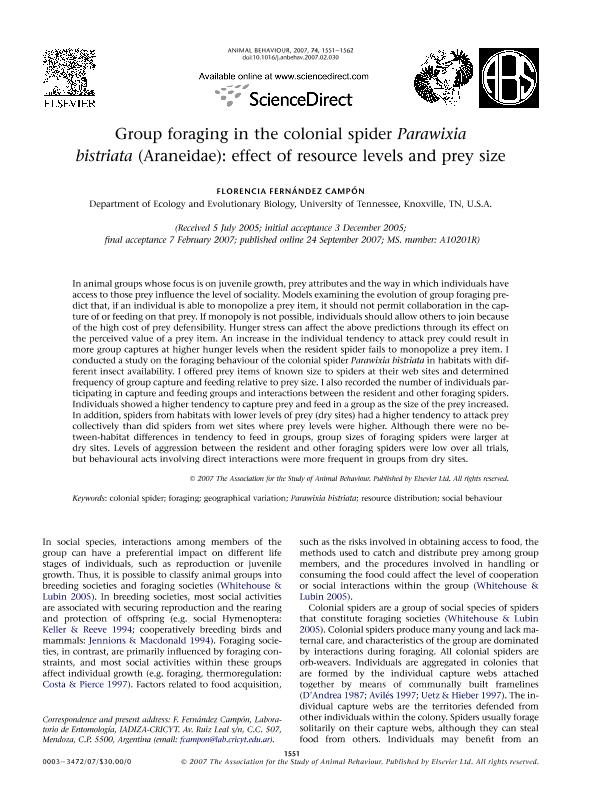Artículo
Group foraging in the colonial spider Parawixia bistriata (Araneidae): effect of resource levels and prey size
Fecha de publicación:
11/2007
Editorial:
Academic Press Ltd - Elsevier Science Ltd
Revista:
Animal Behaviour
ISSN:
0003-3472
Idioma:
Inglés
Tipo de recurso:
Artículo publicado
Clasificación temática:
Resumen
In animal groups whose focus is on juvenile growth, prey attributes and the way in which individuals have access to those prey influence the level of sociality. Models examining the evolution of group foraging predict that, if an individual is able to monopolize a prey item, it should not permit collaboration in the capture of or feeding on that prey. If monopoly is not possible, individuals should allow others to join because of the high cost of prey defensibility. Hunger stress can affect the above predictions through its effect on the perceived value of a prey item. An increase in the individual tendency to attack prey could result in more group captures at higher hunger levels when the resident spider fails to monopolize a prey item. I conducted a study on the foraging behaviour of the colonial spider Parawixia bistriata in habitats with different insect availability. I offered prey items of known size to spiders at their web sites and determined frequency of group capture and feeding relative to prey size. I also recorded the number of individuals participating in capture and feeding groups and interactions between the resident and other foraging spiders. Individuals showed a higher tendency to capture prey and feed in a group as the size of the prey increased. In addition, spiders from habitats with lower levels of prey (dry sites) had a higher tendency to attack prey collectively than did spiders from wet sites where prey levels were higher. Although there were no between-habitat differences in tendency to feed in groups, group sizes of foraging spiders were larger at dry sites. Levels of aggression between the resident and other foraging spiders were low over all trials, but behavioural acts involving direct interactions were more frequent in groups from dry sites.
Archivos asociados
Licencia
Identificadores
Colecciones
Articulos(IADIZA)
Articulos de INST. ARG DE INVEST. DE LAS ZONAS ARIDAS
Articulos de INST. ARG DE INVEST. DE LAS ZONAS ARIDAS
Citación
Fernández Campón, María Florencia; Group foraging in the colonial spider Parawixia bistriata (Araneidae): effect of resource levels and prey size; Academic Press Ltd - Elsevier Science Ltd; Animal Behaviour; 74; 5; 11-2007; 1551-1562
Compartir
Altmétricas




